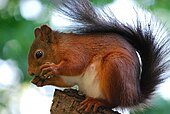Mexican gray squirrel
| Mexican gray squirrel | |
|---|---|

| |
| Scientific classification | |
| Domain: | Eukaryota |
| Kingdom: | Animalia |
| Phylum: | Chordata |
| Class: | Mammalia |
| Order: | Rodentia |
| Family: | Sciuridae |
| Genus: | Sciurus |
| Species: | S. aureogaster
|
| Binomial name | |
| Sciurus aureogaster F. Cuvier, 1829
| |
| Subspecies[2] | |
| |

| |
| Mexican gray squirrel range | |
The Mexican gray squirrel (or red-bellied squirrel) (Sciurus aureogaster) is a tree squirrel in the genus Sciurus native to Guatemala and eastern and southern Mexico. It has been introduced to the Florida Keys.[3][1]
The alternate name of this squirrel (red-bellied squirrel) should not be confused with the Indonesian red-bellied squirrel (Rubrisciurus rubriventer) or the Asian red-bellied tree squirrel (Callosciurus erythraeus).
Sciurus aureogaster most often chooses West Indian mahogany trees to build nests. However, since the introduction of the species to Florida in the late 1930s, its nesting locations have become more irregular, nesting in varying species of trees and even choosing to nest in hurricane debris. [4]
The two subspecies each have many synonyms associated with them:[2]
- The subspecies S. a. aureogaster was also known as S. a. chrysogaster, S. a. ferruginiventris, S. a. hypopyrrhus, S. a. hypoxanthus, S. a. leucogaster, S. a. maurus, S. a. morio, S. a. mustelinus, S. a. raviventer and S. a. rufiventris.
- The subspecies S. a. nigrescens was also known as S. a. affinis, S. a. albipes, S. a. cervicalis, S. a. chiapensis, S. a. cocos, S. a. colimensis, S. a. effugius, S. a. frumentor, S. a. griseoflavus, S. a. hernandezi, S. a. hirtus, S. a. leucops, S. a. littoralis, S. a. nelsoni, S. a. nemoralis, S. a. perigrinator, S. a. poliopus, S. a. quercinus, S. a. rufipes, S. a. senex, S. a. socialis, S. a. tepicanus, S. a. varius and S. a. wagneri.
References
- ^ a b Koprowski, J.; Roth, L.; Reid, F.; Woodman, N.; Timm, R.; Emmons, L. (2008). "Sciurus aureogaster". IUCN Red List of Threatened Species. 2008. Retrieved 6 January 2009.
{{cite journal}}: Invalid|ref=harv(help); Unknown parameter|last-author-amp=ignored (|name-list-style=suggested) (help) - ^ a b Thorington, R.W. Jr.; Hoffmann, R.S. (2005). "Sciurus (Sciurus) aureogaster". In Wilson, D.E.; Reeder, D.M (eds.). Mammal Species of the World: a taxonomic and geographic reference (3rd ed.). The Johns Hopkins University Press. pp. 754–818. ISBN 0-8018-8221-4. OCLC 26158608.
{{cite book}}: External link in|chapterurl=|chapterurl=ignored (|chapter-url=suggested) (help) - ^ Long, J. L. (2003). Introduced Mammals of the World: Their History, Distribution and Influence. Csiro Publishing, Collingwood, Australia. ISBN 9780643099166
- ^ Ramos-Lara, Nicolás, and Fernando A. Cervantes. “ECOLOGY OF THE MEXICAN RED-BELLIED SQUIRREL (SCIURUS AUREOGASTER) IN MICHOACÁN, MEXICO.” The Southwestern Naturalist, vol. 56, no. 3, 2011, pp. 400–403. JSTOR, www.jstor.org/stable/23028144. Geoffrey H. Palmer, John L. Koprowski, Anthony J. Pernas, Nest tree and site selection of an introduced population of red-bellied squirrels (Sciurus aureogaster), Journal of Mammalogy, Volume 94, Issue 6, 16 December 2013, Page
External links
- Photos of Mexican Gray squirrels in Parque de Los Berros — park in Xalapa, Veracruz state, Mexico.




